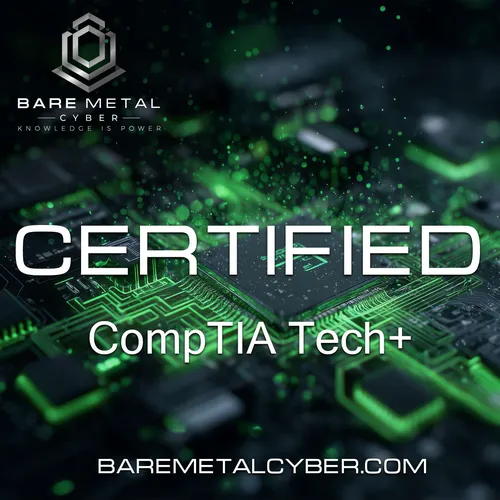
Certified - CompTIA Tech+ Audio Course
The Tech+ Audio Course is a complete audio study companion for the CompTIA Tech+ (FC0-U71) certification exam, designed to guide learners through every domain and objective. Each episode delivers clear explanations, practical examples, and exam-focused insights to help you build confidence and technical readiness. Whether you are new to IT or preparing for your first certification, this PrepCast provides structured support from start to finish.
- Update frequency
- every day
- Average duration
- 13 minutes
- Episodes
- 59
- Years Active
- 2025

Episode 39: AI in Tech+: Chatbots, Generative Tools, and Smart Systems
This episode introduces artificial intelligence concepts relevant to the Tech+ exam, including AI chatbots, assistants, and generative AI tools. We explain how AI can produce code, create content, an…

Episode 38: Browser Configurations: Extensions, Privacy, and Sync
This episode focuses on configuring web browsers for security, efficiency, and personalization. We cover the use of extensions and add-ons, private browsing modes, cache management, and pop-up blocki…

Episode 37: Software Use Cases: Productivity, Collaboration, and Support
This episode reviews the main categories of software you will encounter in the exam, including productivity tools, collaboration platforms, and support utilities. We explain how word processors, spre…

Episode 36: OS Roles: Application, Task, and Device Management
This episode explains the primary roles of an operating system, focusing on how it manages applications, tasks, and connected devices. We detail how the OS provides an interface between hardware and …

Episode 35: OS Components: Filesystems, Drivers, and Interfaces
This episode explores the core components of an operating system, including filesystems, device drivers, and user interfaces. We explain how these components work together to manage hardware resource…

Episode 34: Applications and Software: Domain Overview
This episode provides an overview of the Applications and Software domain, explaining how it addresses operating systems, productivity tools, browser configuration, and AI concepts. You will learn ho…

Episode 33: Wireless Capabilities: Standards, Speeds, and Interference
This episode covers the essential aspects of wireless networking, focusing on standards such as 802.11n, 802.11ac, and 802.11ax. We discuss the speed capabilities, frequency bands, and range consider…

Episode 32: Network Types and Models: LAN, WAN, Client-Server, P2P
This episode introduces the most common network types and architectures, including Local Area Networks, Wide Area Networks, client-server models, and peer-to-peer setups. We explain the characteristi…

Episode 31: Network Services: Web, File Transfer, Email, and Devices
This episode examines the essential network services you will encounter in both the exam and real-world IT environments. We cover secure web browsing, file transfer protocols, and email services, exp…

Episode 30: Networking Basics: Addressing, Ports, and Communication
This episode covers the fundamental concepts of network communication, including IP addressing, MAC addresses, and port numbers. We explain how these identifiers allow devices to locate and communica…

Episode 29: Internet Services: Fiber, DSL, Satellite, and Cellular
This episode reviews the primary types of internet services, explaining their technologies, capabilities, and limitations. We cover wired options like fiber optic and DSL, along with wireless service…

Episode 28: Deployment Models: On-Prem, Cloud, and Hybrid Compared
This episode explains the main deployment models for IT infrastructure—on-premises, cloud, and hybrid—and the scenarios in which each is most effective. We describe how on-premises models offer direc…

Episode 27: Cloud Delivery Models: SaaS, PaaS, and IaaS
This episode examines the three primary cloud service models—Software as a Service, Platform as a Service, and Infrastructure as a Service—outlining their purposes, advantages, and limitations. We br…

Episode 26: Virtualization and Cloud: Core Concepts and Hypervisors
This episode introduces virtualization and cloud computing concepts, explaining how they enable more efficient use of computing resources. We define key terms such as hypervisor, guest operating syst…

Episode 25: Display Connectors: VGA, HDMI, DisplayPort, and USB-C
This episode explains the features, capabilities, and differences between common display connectors, including VGA, HDMI, DisplayPort, and USB-C. You will learn how each interface handles video, audi…

Episode 24: Input/Output Interfaces: USB, Thunderbolt, RF, and Bluetooth
This episode covers the common input/output interfaces you will encounter, including USB variants, Thunderbolt, radio frequency connections, and Bluetooth. We discuss the specifications, capabilities…

Episode 23: Plug-and-Play vs. Driver Installs: Installation Types Explained
This episode explains the differences between plug-and-play installations, where the operating system automatically configures the device, and manual driver installations, which require user interven…

Episode 22: Peripheral Devices: Common Installations and Setup Methods
This episode covers the installation and configuration of common peripheral devices such as printers, scanners, webcams, external drives, and display units. We explain how different installation type…

Episode 21: Local vs. Network Storage: Flash, NAS, and Cloud Options
This episode explains the differences between local storage options such as USB flash drives, SD cards, and internal drives, versus network-based storage solutions like NAS devices and cloud services…

Episode 20: Storage Technologies: HDD, SSD, NVMe, and Optical Compared
This episode compares the major types of storage technologies you need to understand for the exam. We explain the characteristics, advantages, and disadvantages of HDDs, SSDs, NVMe drives, and optica…